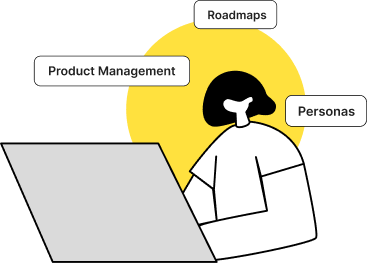A product roadmap is more than just a checklist of forthcoming features and issues. It captures your high-level product direction, demonstrates your work to reach your objectives, and presents it on a visual completion schedule. Your product roadmap is a stand-alone document that conveys progress and illustrates how the work of the whole product team contributes to the overall plan. It’s easy to get lost in the maze of roadmaps, and these are all questions that you may hear as a product manager from anybody in your company, from sales and engineering to customer success and marketing. And, sure, it may be aggravating.
Most product roadmaps have the same components, but product managers must consider several aspects to create the correct roadmaps, such as your target audience, the roadmap’s goal, the amount of information, and the timescale. This article will look at five product roadmap examples to help you create visually attractive visualizations for various circumstances.
A strategic product roadmap often includes the following significant points:
- Product vision describes what you want your product to be in the future.
- A strategy is an action plan that details your firm’s actions to achieve the goal.
- A goal is a time-bound target that can be quantified using a particular metric.
- The initiative is broad themes that bring together characteristics that must be executed to reach a goal.
- A feature is a physical product component that is either part of the functionality or a third-party application.
- Time-frames are the dates or intervals for completing a specific objective or feature. A product roadmap, in general, merely provides an estimate.
- Work progress is tracked using status indicators.
- Metrics aid in measuring data-driven objectives such as churn rate or organic traffic.
Any product plan must be clear and easy to comprehend. This enables a product manager to supervise all development teams while remaining connected with customer demands and corporate goals. As a result, a product roadmap is relevant and appropriate when it fits the following criteria:
- The product development plan is communicated.
- demonstrates the product’s vision
- Evolves and adapts to product and market demands.
- Prioritizes high-level development units
- Serves as a means of communication for all parties concerned.
- Establishes long-term timetables
- Indicates specific aims and connects them to corporate objectives.
Beautiful product roadmaps focus your product team on the most critical tasks and explain why your efforts are crucial. Furthermore, attractive product roadmaps inspire enthusiasm and buy-in from executives, cross-functional coworkers, and customers outside your core team.
Let us examine the significance of roadmapping from various perspectives.
Importance of Roadmap
In terms of organizational structure
Product roadmapping provides a framework for executive leadership and design. It generates a timeline representing a team’s or company’s varied deadlines and work durations. It enables project leaders, department supervisors, or managers to assign and supervise particular product development activities. Product roadmapping creates a structured plan for products.
For product creators and team members
Roadmaps document what developers can offer to stakeholders to earn their support and popularity. It provides an awareness of the company’s aims and objectives, allowing team members to concentrate on the most vital tasks and make quick independent choices. Roadmaps create a unified strategy since they are a tool that offers a corporation’s objectives and a timeframe to follow. Team members may concentrate on the timescale to boost their productivity while accomplishing the goals of the product plan.
Product management teams
Product roadmapping aids in the coordination of groups working on high-impact product changes. It enables them to communicate priorities with neighboring groups efficiently. Roadmapping promotes cooperation and visualizes how one department’s responsibilities influence the project, other departments, or the firm.
For stakeholders
Roadmapping assists stakeholders such as corporate executives and investors in comprehending firm strategies, assignments, and structures. It enables investors to understand how developers intend to manufacture and market a product. This might enhance their willingness to invest in development. Roadmaps enable stakeholders to communicate their ideas and provide input to help the product development.
Now that we’ve covered the fundamentals of roadmapping, it’s time to put our knowledge to use in creating roadmaps.
Here are five visual product roadmaps to help you make your own. Each model presents comparable information in some parts while reducing others.
As you may be aware, we conducted roadmapping trials with Netflix’s hypothetical features.
As a result, for this blog, we will take the same Netflix features and present them in the different roadmaps

| – Custom playlists and an Improved “My List” – Partnership with IMDB or Rotten Tomatoes – Push notification or reminder device for when films are expiring – Easy access to international content Offering free trials for new users – Live streaming for gaming enthusiasts. – Add function to increase volume – Enable landscape orientation on phones and tablets. |
Now that the features have been specified, how about we organize them into separate roadmaps?
Quarter Based Roadmap
While quarterly release plan roadmaps vary somewhat from product roadmaps in form and purpose, they are a helpful tool for product managers and technical teams. Quarterly release plans are intended to fall in between broad vision statements and detailed project plans. They depict the product’s direction, how it will get there, and what stakeholders might anticipate. This roadmap for a release plan is an example of how a team that produces quarterly releases may approach outlining their strategy. The features are sorted by priority level, so the most vital information is immediately absorbed.
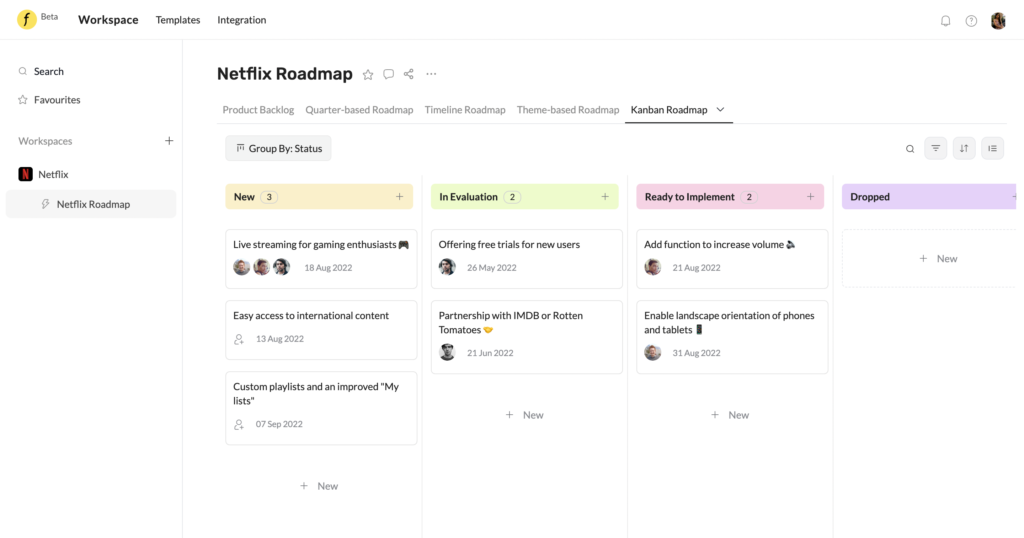
An example of a Quarter Based Roadmap created in Freshflows
Timeline Roadmap
Timeline roadmaps are most typically used by product managers to establish alignment with stakeholders and cross-functional teams. A timeline roadmap may be used for a variety of strategic goals. For starters, it conveys the priority order of a team’s objectives depending on when they intend to begin working on each one. It also specifies how much time the team anticipates devoting to each project. Lastly, a timeframe roadmap informs the organization when each endeavor should be finished. Stakeholders can clearly understand major initiatives’ objectives and duration, and cross-functional teams may readily coordinate launch events with clear deadlines. Consider picking a period that works best for comprehensive communication of your intentions. This might be monthly, quarterly, or whatever time frame you believe is appropriate for your or your stakeholders’ requirements.
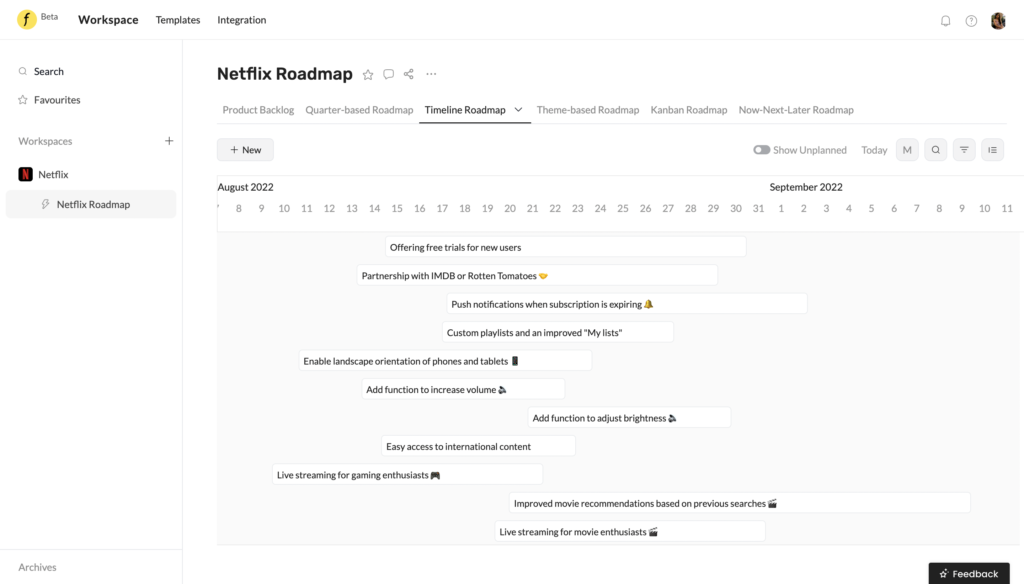
An example of a Timeline Roadmap created in Freshflows
Theme Based Roadmap
Simply described, a theme-based roadmap is divided into strategic topics. A theme-based product roadmap may assist product managers in thinking about outcomes rather than features. A theme-based product roadmap is an excellent method for categorizing objectives and plans at the highest level. Choosing themes over parts may help your team make better strategic and tactical choices, convince leaders, and produce better products. This theme-based product roadmap template is designed to keep a high-level blueprint of a team’s objectives and ambitions regarding the product strategy.
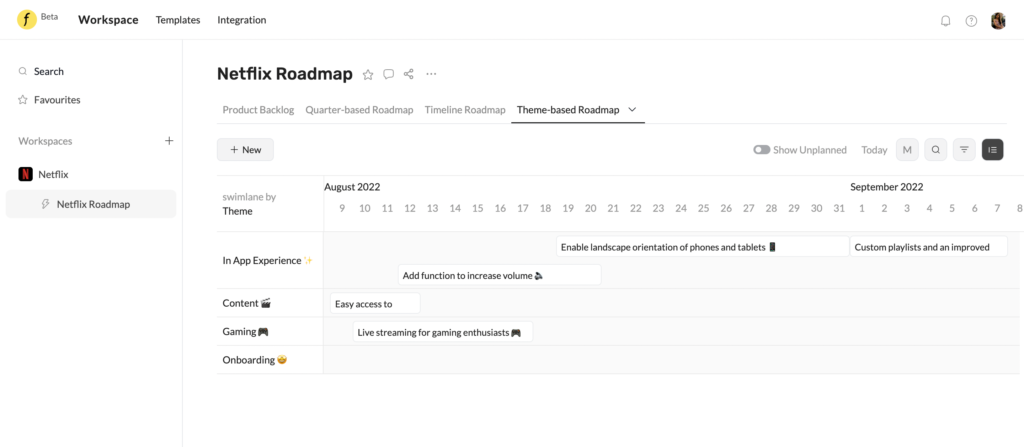
An example of Theme Based Roadmap created in Freshflows
A Kanban roadmap is a development team’s delivery-focused plan. It assists product teams in categorizing efforts such as what is in the backlog, what is planned, what is in process, and what has been accomplished. One of the most important benefits of a Kanban roadmap is that it enables product teams to express their short-term intentions without committing to specific dates. You may demonstrate when you’re working on certain features and keep your delivery team motivated by reminding them of their work.
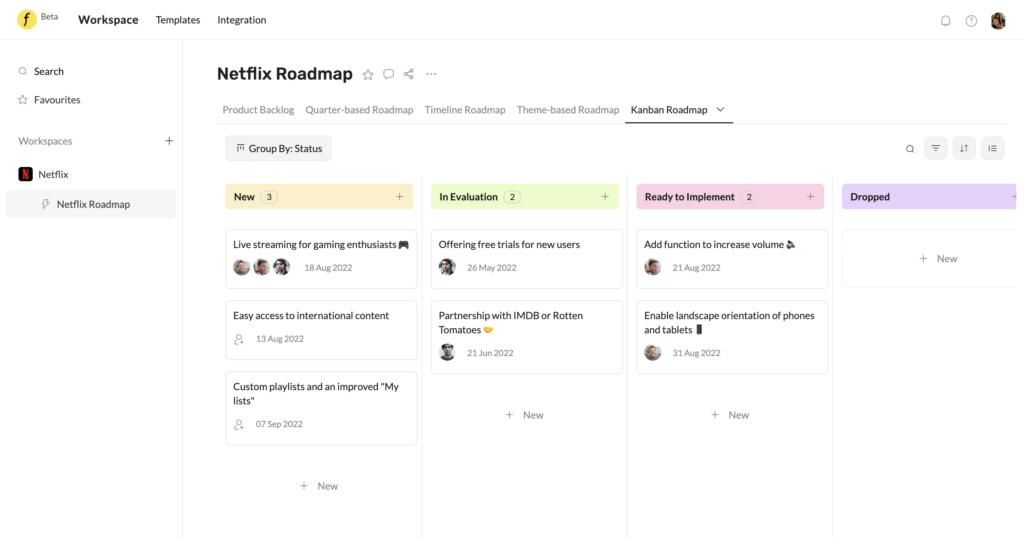
An example of a Kanban Roadmap created in Freshflows
Similar to a Kanban, this view displays the delivery items with an emphasis on the near-term and no deadlines set in stone. However, this articulates their priority rather than status. Functionality in the Now column is the highest priority, while the Later items are for the longer term. A similar format is Must Have, Should Have, Could Have, Won’t Have.
Additionally, the cards on the board can be further categorized by grouping them under the business objectives they support and are most relevant to. This shows how the plans are comprehensively aligned to the organization’s strategy. It is worth noting that a robust prioritization process is required to keep this board updated as the environment changes.

An example of a Now-Next-Later Roadmap created in Freshflows
Each product is critical to your company and ROI; if the development and maintenance processes are not well planned, they will almost certainly fail at some time. That’s where a roadmap comes into place – an essential document for any product development team.
Every product requires a strategy, and every plan requires a roadmap. Consider investing in Freshflows if you’re ready to develop spectacular product roadmaps. Our roadmapping software lets you quickly generate, tweak, and share professional product roadmaps. You may choose from templates and customize the aesthetic aspects to your specifications, allowing you to take pleasure in every product roadmap you create.

